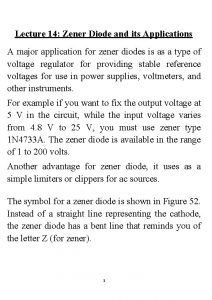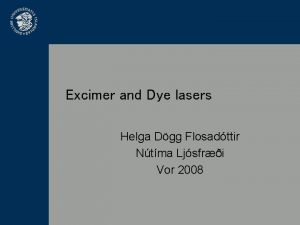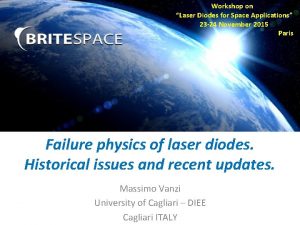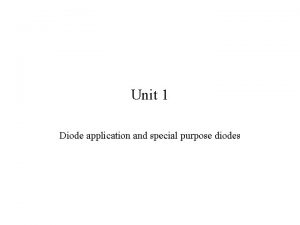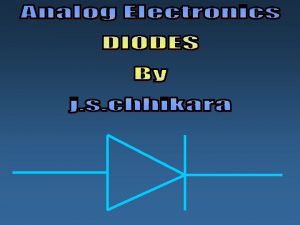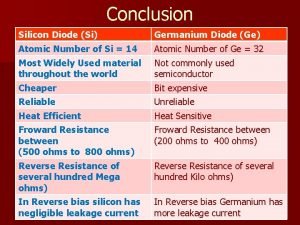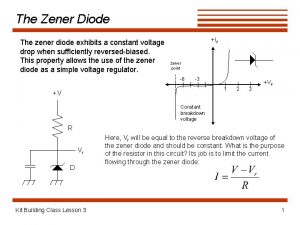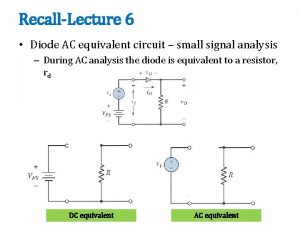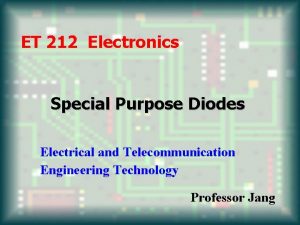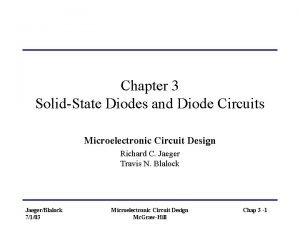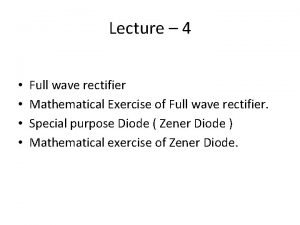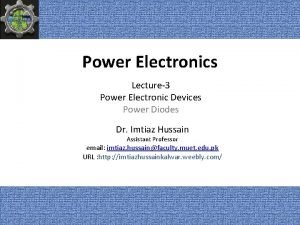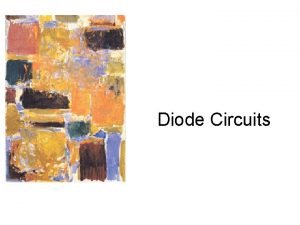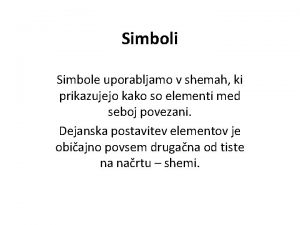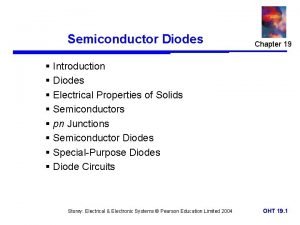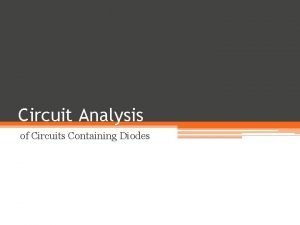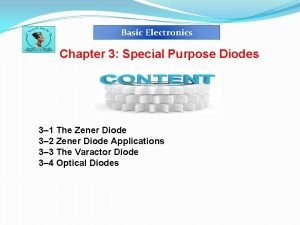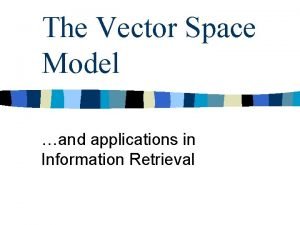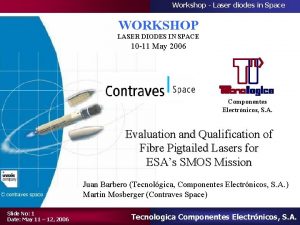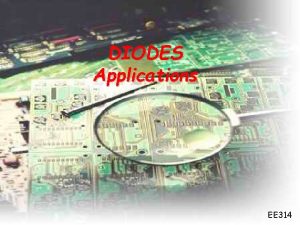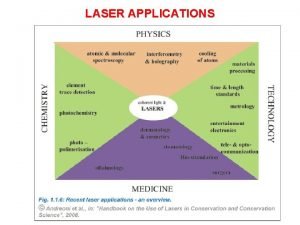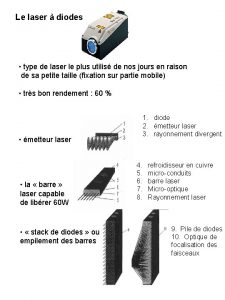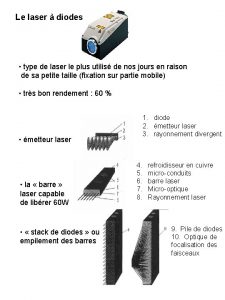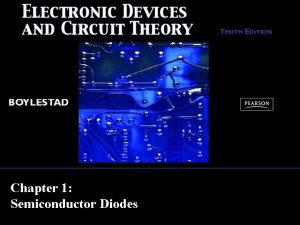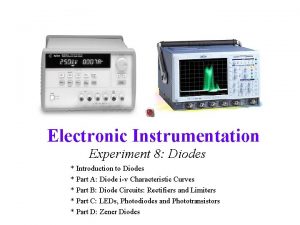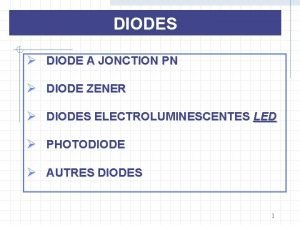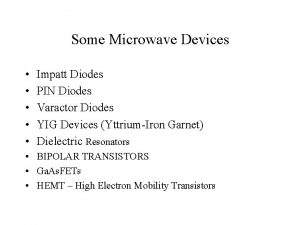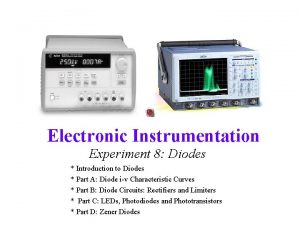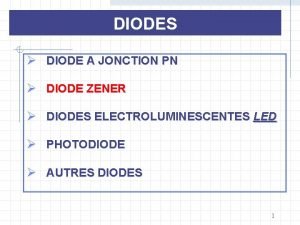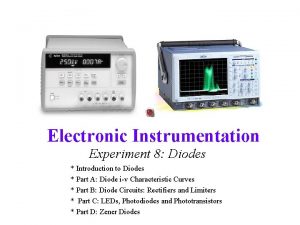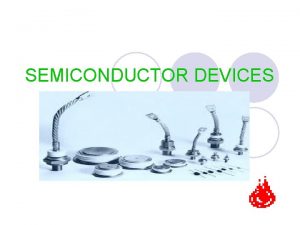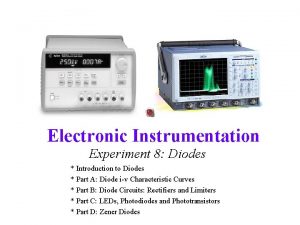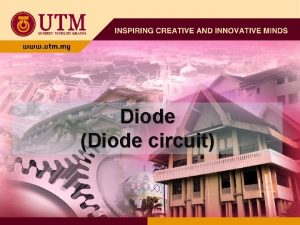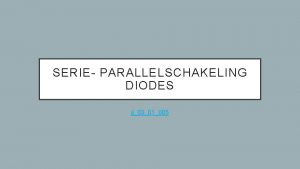Workshop on Laser Diodes for Space Applications 23






















![TEM results Transversal cut (reference device) 1 mm [100] [111] [100] [110] [100] SL TEM results Transversal cut (reference device) 1 mm [100] [111] [100] [110] [100] SL](https://slidetodoc.com/presentation_image_h2/c86c0e3663e4f17cd4d622a3091a006d/image-23.jpg)























- Slides: 46

Workshop on “Laser Diodes for Space Applications” 23 -24 November 2015 Paris Failure physics of laser diodes. Historical issues and recent updates. Massimo Vanzi University of Cagliari – DIEE Cagliari ITALY

Outline: • What we said 10 years ago (Toulouse, May 2006) • Second Harmonics and CODs • Transient radiation effects • Conclusions?

Outline: • Failure Analysis of lasers: a puzzling question • Paleophotonics examples • The early ’ 80 s: the era of Burn Out, COD and DLD • The late 80’s: In. P/In. Ga. As. P structures. The ESD epics • The ‘ 90 s: laser pumps for fiber amplification. Sudden failures and REDR • The 2 Ks: external tunable devices. Is the chip the major issue? • The evolution of an electrical/optical model for laser degradations • Conclusions ? Toulouse, 12/05/2006

Analyzing a failed laser diode in ’ 80 s: 1) Find the head and the tail of the dog 2) The total set of informations: it does no more light 3) Your instruments: hammer, saw, drill, an optical microscope (maybe IR) and the not yet widespread SEM. An electrical curve tracer. In that period, Technology and Reliability ran a furious race, with the latter continuously trying to discover the new failure mechanisms intrinsic to the new devices, to invent suitable techniques to detect them, to model their kinetics, to find any precursor able to early point out any risk occurrence. Toulouse, 12/05/2006

Early 80’s. The Al. Ga. As/Ga. As laser era. A failed laser is: • an optical emitter whose output power decreased below tolerances • an electrical diode shorted, open or leaky. Quite rarely OK. • a microscopic object, whose observation requires IR for optical microscopy, and whose active region is smaller or comparable with the optical resolution. • an interesting specimen for EBIC, provided its detailed structure is known and a reference is available. Toulouse, 12/05/2006

1982: paleophotonics/1 • A primitive soldering process • The faithful EBIC response Secondary electrons e-beam ù EBIC Toulouse, 12/05/2006

paleophotonics/2 EBIC again: the discovery of a parasitic diode. Mechanism: corrosion In both cases the die attach was the origin of the problem: bad material, bad deposition/soldering process. In both cases, also, the photonic degradation was nearly negligible: some slight increase of the required current (leakage) EBIC started to play the role of a suitable technique for investigating LDs Toulouse, 12/05/2006

The golden age of Burn-Out: it explained everything, and always EOS (Electrical Over Stress) was indicted for the crime. …and even it seemed not so wrong, SEM detail EBIC detail until EBIC started to reveal lattice-oriented dark stripes at the “burned” mirrors A “ghost” was evoked: the mysterious COD (Catastrophic Optical Damage) whose only known feature was to affect the laser mirrors. Toulouse, 12/05/2006

Just in time to discover dark lines also inside some optically degraded lasers SEM EBIC detail Another specimen EL reference EL common to COD and DLD …and to create another “pseudo-mechanism” : the DLD (Dark Line Defects), a tautology for the failure mode. NOT a failure mechanism. Toulouse, 12/05/2006

It was time to look inside the die. The Cross- Sectional TEM (with no FIB…) DLDs appeared as a network of dislocations and of dislocation loops, evolving from native defects at the epitaxial Al. Ga. As/Ga. As interfaces under the effect of temperature (and recombination, as demonstrated years later) Toulouse, 12/05/2006

Late ’ 80 s: The In. P/In. Ga. As. P Buried Crescent structure In. P/In. Ga. As. P BC laser facet after dielectric removal and stain np diode ? pn diode EBIC on untreated facets 1988: EBIC proves suitable also for direct inspection of laser facets Surface conduction seems to affect EBIC mapping even on good devices… … as well as lattice defects. EBIC “whiskers” running along the p-In. P epitaxial surface of the Buried Crescent structure regular anomalous Toulouse, 12/05/2006

POUT(m. W) Newton rings monitor front facet optical IL(m. A) Optical, on a nearby zone SEM EBIC Degradation after THB tests. Mechanism: detachment of the mirror coating IL(m. A) leaky diode reference VL(V) A beautiful way for revealing anomalous surface states, responsible for detectable electrical effects (leakage) Toulouse, 12/05/2006

The ESD epics failed Under ESD tests the laser diodes fail. The usual failure mode is a short circuit, and EBIC shows junction perforation at least at one of the facets. reference (from A. Urbieta, G. Zanon, IBM France, proc. ESREF 90) Toulouse, 12/05/2006

1991: the unusual behavior of In. P/In. Ga. As. P devices The latest “praeternatural” interpretation: loss of confinement (!) Toulouse, 12/05/2006

Back to earth: one of the most difficult Failure Analyses The set of observations: a real puzzle Toulouse, 12/05/2006

First step: a phenomenological model, and a set of parameters to trim A layer of defects MUST exist confined inside the 1000 Å thick, 3 mm wide, active region, running for hundreds micrometers. You should show it and explain its formation under ESD stress. Toulouse, 12/05/2006

Here it is! Toulouse, 12/05/2006

Time evolution of the Euler’s surface This failure analysis was the prompt to propose, in 1995, the “Rules of the Rue Morgue”: a prayer for scientific methods in both procedures and hypotheses within the reliability community. Toulouse, 12/05/2006

The ’ 90 s: The pump lasers for EDFAs (and, later, for Raman) New technologies: Quantum Wells, Strained Lattice. New wavelengths: 980 nm High current, high power: new mechanisms expected And a new failure mode: sudden failures, even after thousand hours of regular life An extremely subtle feature of the failure mode: sudden failures occurred according to an exponential distribution, that is at constant rate. It seemed the fingerprint of casual events… Toulouse, 12/05/2006

How can defects suddenly hit a laser, after a long silent time? The REDR (Recombination Enhanced Defect Reaction) mechanism: Defects flowed by minority carriers diffusing from a forward biased junction will reach the depletion layer within a time proportional to the exponential of the distance They will affect the diode only at that time. Externally, it seems a sudden event Toulouse, 12/05/2006

REDR in SL laser diodes: a possible root for sudden failures In Strained Lattice Double Heterostructures (SQW In. Ga. As/Al. Ga. As laser): fast strain release after the delayed arrival of the gliding defect p n Expected findings: Current sinking by non-radiative recombination Displacement of the current threshold Long dark strips in EBIC Network of misfit dislocations ([110] preferential)at FIB/TEM Toulouse, 12/05/2006

EBIC-driven FIB/TEM EBIC SEM FIB cuts TEM specimen Toulouse, 12/05/2006
![TEM results Transversal cut reference device 1 mm 100 111 100 110 100 SL TEM results Transversal cut (reference device) 1 mm [100] [111] [100] [110] [100] SL](https://slidetodoc.com/presentation_image_h2/c86c0e3663e4f17cd4d622a3091a006d/image-23.jpg)
TEM results Transversal cut (reference device) 1 mm [100] [111] [100] [110] [100] SL In. Ga. As [110] Longitudinal cut [100] [110] Toulouse, 12/05/2006

Evidence from high power devices (ESREF 2000) Overstressed sample: no evident, extended dislocation patterns, but a limited region of strange contrast. . . …limited by an ellipsoidal boundary, resembling the expected “hot” region around the emission area 2 mm Fusion and re-crystallization, as for the “old” devices Toulouse, 12/05/2006

Suddenly failed device: nearly perfect lattice SL In. Ga. As “deleted” from nearly spherical shapes No defects even at higher magnification 1 single “dark” point centered Toulouse, 12/05/2006

Suddenly failed device: the same mechanism, but starting from a different heath source: a [110] line laying inside the SL In. Ga. As: a typical misfit dislocation It acts as a hot rod because of its twofold energy sinking role: 1) 2) energy released by excess carrier recombination photon absorbption because of local recombination-induced transparency loss And cannot be a native defect… REDR Toulouse, 12/05/2006

2000 s: the external cavity tunable devices. optics monitor diode filters external mirror laser chip • Impossible to apply lifetest-level stress to an assembled module • Impossible to test the single chip: no laser emission • Accelerated life tests only possible on Fabry-Perot chips: are results meaningful? • Is chip reliability still the major issue? Toulouse, 12/05/2006

Two characteristics at known PT allow to calibrate the model and fit the threshold current and the optical efficiency at other loss levels Pout(m. W) 16. 5 d. B 17. 5 d. B 20 d. B 23 d. B I(m. A) Toulouse, 12/05/2006

Conclusions ? • Reliability: a never concluded job • The race continues along the main streams of: • Technological Characterization • Technique experimentation and development • Specimen handling • Failure Physics • Device modeling • See you at the next decade Toulouse, 12/05/2006

2010 Fukuda at ISROS

2° Harmonics and CODs (unpublished) • 2° harmonics induced by COD • COD induced by 2° harmonics

2° harmonics induced by COD In. P-based 1310 nm DFB laser diodes failed during field operation


COD induced by 2° harmonics induced by COD Fiber DBR 980 nm pump laser diodes PV XV

Superposition of Hermite Gauss modes 1 st COD defects 2 nd COD

COD induced by 2° harmonics What did excite the high-order side-modes? D E H IS L 1310 nm DFB UB P source Bof. E an O integrated EA T T modulator NO

Transient Radiation Effects (RADECS 2015)

Proton Irradiation Ion Energy 3 Me. V 3 x 1012 particles/cm 2 1310 nm In. P edge emitter Projected range 60 mm 850 nm Ga. As VCSEL Hypothesis: • Proton density in active region Increase of non-radiative events Increase of Ith Decrease of ηT

Data analysis VCSEL Ith=3. 26 m. A Ith 1=4. 10 m. A DFB Ith=5. 51 m. A Ith 1=6. 5 m. A The proton irradiation induced both an increase of the threshold current Ith and a corresponding decrease of the total optical efficiency ��. reasonable TQuite

Time evolution of characteristics of unbiased devices Step 0 = pre-irradiation Step 1 = just after irradiation Step 2 = 2 hours Step 3 = 1 week Step 4 = 2 weeks Step 5 = 1 month

Data analysis VCSEL DFB Hypothesis: • Nuclear activation • Proton diffusion • Proton ‘‘recombination’’ Negligible Dominant Negligible

Proton diffusion Théorie de la chaleur Fourier (1822) Heat equation Diffusion Equation Solution by convolution Green function G Gaussian profile of implantation C 0 Infinite three-dimensional domain

Proton diffusion DF B implanted protons VCSEL Not infinite 3 D domain: G Image method from electrostatics

2 mm 1 mm implanted protons VCSEL 60 mm DFB t = 2 weeks H diffusion coefficient in Si DFB VCSEL

Discussion and conclusions: • Results: • Negligible nuclear activation effects for 3 Me. V H+ • Degradation mechanism related to proton density • Proton diffusion consistent with measurements • Open points: • The fourth measurament of DFB • The fast recovery of VCSEL ( «recombination» ? ) • The finite value of ΔRp • Further investigations: • Kinetics at different temperatures • Kinetics under operational life • Kinetics under combined stresses (T, I)

General Conclusions Never assume that Laser Diode Reliability will have no more surprises • See you within ten years Thank you
 Zener diode application
Zener diode application Excimer laser applications
Excimer laser applications Laser interferometer space antenna
Laser interferometer space antenna Diodes
Diodes Special purpose diode
Special purpose diode What are diodes made of
What are diodes made of Conclusion sur les diodes
Conclusion sur les diodes Zener diode exhibits
Zener diode exhibits Zener diode equivalent circuit models
Zener diode equivalent circuit models Et 212
Et 212 Solid state diode definition
Solid state diode definition Rectifier advantages and disadvantages
Rectifier advantages and disadvantages Power diodes types
Power diodes types Practical diode model
Practical diode model Simboli dioda
Simboli dioda Introduction to diodes
Introduction to diodes Circuit analysis with diodes
Circuit analysis with diodes Special purpose diodes
Special purpose diodes Pole star space applications
Pole star space applications Aqueryn
Aqueryn Iso 22301 utbildning
Iso 22301 utbildning Typiska novell drag
Typiska novell drag Nationell inriktning för artificiell intelligens
Nationell inriktning för artificiell intelligens Ekologiskt fotavtryck
Ekologiskt fotavtryck Shingelfrisyren
Shingelfrisyren En lathund för arbete med kontinuitetshantering
En lathund för arbete med kontinuitetshantering Personalliggare bygg undantag
Personalliggare bygg undantag Tidbok för yrkesförare
Tidbok för yrkesförare Sura för anatom
Sura för anatom Densitet vatten
Densitet vatten Datorkunskap för nybörjare
Datorkunskap för nybörjare Tack för att ni lyssnade bild
Tack för att ni lyssnade bild Tes debattartikel
Tes debattartikel För och nackdelar med firo
För och nackdelar med firo Nyckelkompetenser för livslångt lärande
Nyckelkompetenser för livslångt lärande Påbyggnader för flakfordon
Påbyggnader för flakfordon Kraft per area
Kraft per area Publik sektor
Publik sektor Jag har nigit för nymånens skära
Jag har nigit för nymånens skära Presentera för publik crossboss
Presentera för publik crossboss Jiddisch
Jiddisch Plats för toran ark
Plats för toran ark Klassificeringsstruktur för kommunala verksamheter
Klassificeringsstruktur för kommunala verksamheter Epiteltyper
Epiteltyper Claes martinsson
Claes martinsson Cks
Cks Programskede byggprocessen
Programskede byggprocessen
